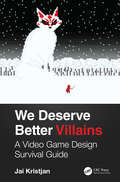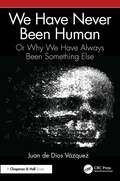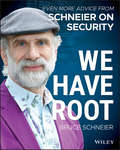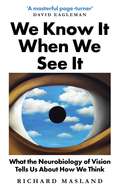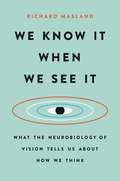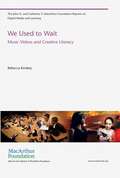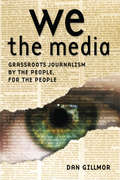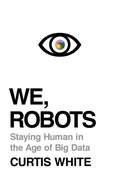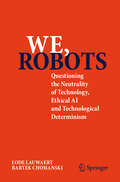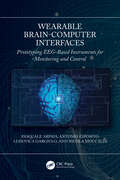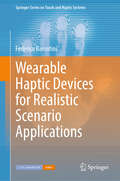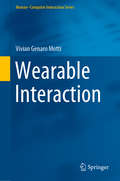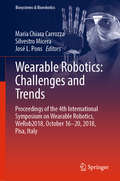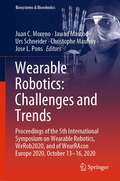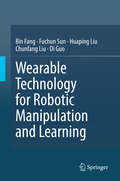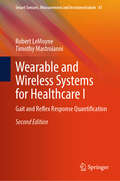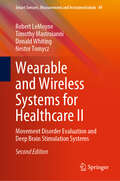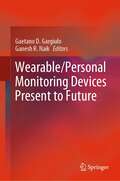- Table View
- List View
We Deserve Better Villains: A Video Game Design Survival Guide
by Jai KristjanWe Deserve Better Villains is a highly accessible how-to guide for video game designers no matter what level of experience to understand what is needed to be successful in the development cycle of any video game from concept to supporting the game live. Each chapter outlines a period in a video games development cycle, what key concepts need to be on a designers mind and how they can work to improve themselves every step of the way. To help visualize the journey the chapters start with a section centered on the reader as a hero character in a fictitious adventure video game that faces the trials and tribulations of the development cycle to completing the game. We all deserve better games, better heroes and villains which starts with learning what it takes to survive in the game development system as a videogame designer. Key Features Accessible enough for novices, insightful enough for veteran game designers Allows readers of at any level of video game knowledge to connect with the struggle of making a video game Concepts are delivered in a short, specific approach followed with practical exercises to follow to getting the reader into action to improve their skills
We Have Never Been Human: Or Why We Have Always Been Something Else
by Juan de Dios VázquezWe Have Never Been Human: Or Why We Have Always Been Something Else boldly reimagines what it means to be human, challenging the traditional notions that bind our identity to biology and culture. From ancient mythologies to modern technologies, this book reveals a dynamic, ever-evolving human identity shaped by external forces and technological advancements.Blending insights from philosophy, technology studies, anthropology, and cultural critique, We Have Never Been Human: Or Why We Have Been Something Else offers an interdisciplinary exploration of our constructed identities and what they portend for the future of society. It raises essential questions: How has technology reshaped our self-perception? Are humans fixed beings, or are we endlessly evolving? What ethical, social, and political challenges arise as we integrate with intelligent machines?This book is a compelling read for those intrigued by the intersection of humanity and technology, offering profound insights into the essence of what it means to be human—or perhaps, what it means to evolve beyond the human.
We Have Root: Even More Advice from Schneier on Security
by Bruce SchneierA collection of popular essays from security guru Bruce Schneier In his latest collection of essays, security expert Bruce Schneier tackles a range of cybersecurity, privacy, and real-world security issues ripped from the headlines. Essays cover the ever-expanding role of technology in national security, war, transportation, the Internet of Things, elections, and more. Throughout, he challenges the status quo with a call for leaders, voters, and consumers to make better security and privacy decisions and investments. Bruce’s writing has previously appeared in some of the world's best-known and most-respected publications, including The Atlantic, the Wall Street Journal, CNN, the New York Times, the Washington Post, Wired, and many others. And now you can enjoy his essays in one place—at your own speed and convenience. • Timely security and privacy topics • The impact of security and privacy on our world • Perfect for fans of Bruce’s blog and newsletter • Lower price than his previous essay collections The essays are written for anyone who cares about the future and implications of security and privacy for society.
We Just Build Hammers: Stories from the Past, Present, and Future of Responsible Tech
by Coraline Ada EhmkePhilosopher Noam Chomsky is famously quoted as saying that technology is neither good nor bad, but simply a neutral tool. He likens it to a hammer, which can be used by carpenters and torturers alike. While the neutrality of tech is an idea that appeals to many technologists, this perspective is out of alignment with today's realities of pervasive ad-tech, surveillance capitalism, algorithmic manipulation, and rising techno-fascism. We Just Build Hammers applies a lens of speculative and science fiction to connect you with a historical lineage of thinkers and activists in the responsible tech movement. Its narrative spans a century of major technological upheavals: from the advent of the atomic age to the formative years of computing; from the hacker visionaries of the turn of the century to the tech justice revolutionaries of today. This book challenges technologists to consider for themselves whether they're really just "building hammers"– technologies whose potential for good balances their potential for harm– or if they are unwittingly contributing to systems that exacerbate inequality, inequity, and injustice. What You Will Learn A historic grounding and a science fiction perspective to help untangle the difficult and fraught topic of tech ethics Ways to bring ethical considerations into the development of new technologies How to navigate the increasing complexity of the techno-social world we live and work in Who This Book is For Designed to appeal broadly, not just to engineers and technologists, but to anyone interested in the history and future of ethics and technology.
We Know It When We See It: What the Neurobiology of Vision Tells Us About How We Think
by Richard MaslandSpotting a face in a crowd is so easy, you take it for granted. But how you do it is one of science's great mysteries. Vision is involved in nearly a third of everything a brain does and explaining how it works reveals more than just how we see. It also tells us how the brain processes information – how it perceives, learns and remembers. In We Know It When We See It, pioneering neuroscientist Richard Masland covers everything from what happens when light hits your retina, to the increasingly sophisticated nerve nets that turn that light into knowledge, to what a computer algorithm must be able to do before it can truly be called &‘intelligent&’. It is a profound yet accessible investigation into how our bodies make sense of the world.
We Know It When We See It: What the Neurobiology of Vision Tells Us About How We Think
by Richard Maslandp.p1 {margin: 0.0px 0.0px 0.0px 0.0px; font: 13.3px Times} A Harvard researcher investigates the human eye in this insightful account of what vision reveals about intelligence, learning, and the greatest mysteries of neuroscience.Spotting a face in a crowd is so easy, you take it for granted. But how you do it is one of science's great mysteries. And vision is involved with so much of everything your brain does. Explaining how it works reveals more than just how you see. In We Know It When We See It, Harvard neuroscientist Richard Masland tackles vital questions about how the brain processes information -- how it perceives, learns, and remembers -- through a careful study of the inner life of the eye. Covering everything from what happens when light hits your retina, to the increasingly sophisticated nerve nets that turn that light into knowledge, to what a computer algorithm must be able to do before it can be called truly "intelligent," We Know It When We See It is a profound yet approachable investigation into how our bodies make sense of the world.
We Only Dated for 11 Instagrams: And Other Things You'll Overhear in L.A.
by Jesse Margolis Emmet Truxes Eric GarcettiFrom the hugely popular @OverheardLA Instagram account comes this illustrated collection of the entertaining, absurd, sometimes even poignant snippets of conversation overheard on the streets of Los Angeles.Oh, Los Angeles: where kids with lemonade stands accept Venmo, where your Uber driver moonlights as a spiritual adviser. Whether you love L.A. or love to hate it, you'll delight in this comical tribute to the one and only La La Land -- a world all its own, yet also a microcosm of 21st century American culture in so many ways. The book features illustrations from Emmet Truxes, creator of the popular @brooklyncartoons Instagram account, and a foreword from L.A. mayor Eric Garcetti. It's the perfect gift for millennials and everyone who loves to (gently) mock them. Prepare to laugh, to face-palm, to cringe, and to delight in such gems as, "Timing is everything, whether it's sex, drugs, or avocados." "Why are the older generations so judgmental? They were millennials once too." "Nothing screams of desperation like a paragraph of hashtags."And so many more.
We See It All: Liberty and Justice in an Age of Perpetual Surveillance
by Jon FasmanAn investigation into the legal, political, and moral issues surrounding how the police and justice system use surveillance technology, asking the question: what are citizens of a free country willing to tolerate in the name of public safety?As we rethink the scope of police power, Jon Fasman&’s chilling examination of how the police and the justice system use the unparalleled power of surveillance technology—how it affects privacy, liberty, and civil rights—becomes more urgent by the day. Embedding himself within police departments on both coasts, Fasman explores the moral, legal, and political questions posed by these techniques and tools.By zeroing in on how facial recognition, automatic license-plate readers, drones, predictive algorithms, and encryption affect us personally, Fasman vividly illustrates what is at stake and explains how to think through issues of privacy rights, civil liberties, and public safety. How do these technologies impact how police operate in our society? How should archaic privacy laws written for an obsolete era—that of the landline and postbox—be updated?Fasman looks closely at what can happen when surveillance technologies are combined and put in the hands of governments with scant regard for citizens&’ civil liberties, pushing us to ask: Is our democratic culture strong enough to stop us from turning into China, with its architecture of control?
We Used to Wait
by Rebecca KinskeyMusic videos were once something broadcast by MTV and received on our TV screens. Today, music videos are searched for, downloaded, and viewed on our computer screens -- or produced in our living rooms and uploaded to social media. In We Used to Wait, Rebecca Kinskey examines this shift. She investigates music video as a form, originally a product created by professionals to be consumed by nonprofessionals; as a practice, increasingly taken up by amateurs; and as a literacy, to be experimented with and mastered. Kinskey offers a short history of the music video as a communicative, cultural form, describing the rise and fall of MTV's Total Request Live and the music video's resurgence on YouTube. She examines recent shifts in viewing and production practice, tracing the trajectory of music video director Hiro Murai from film student and dedicated amateur in the 1990s to music video professional in the 2000s. Investigating music video as a literacy, she looks at OMG! Cameras Everywhere, a nonprofit filmmaking summer camp run by a group of young music video directors. The OMG! campers and counselors provide a case study in how cultural producers across several generations have blurred the line between professional and amateur. Their everyday practices remake the notion of literacy, not only by their collaborative and often informal efforts to impart and achieve literacy but also by expanding the definition of what is considered a valuable activity, worthy of dedicated, pleasurable pursuit.
We the Media: Grassroots Journalism By the People, For the People
by Dan Gillmor"We the Media, has become something of a bible for those who believe the online medium will change journalism for the better." -Financial Times Big Media has lost its monopoly on the news, thanks to the Internet. Now that it's possible to publish in real time to a worldwide audience, a new breed of grassroots journalists are taking the news into their own hands. Armed with laptops, cell phones, and digital cameras, these readers-turned-reporters are transforming the news from a lecture into a conversation. In We the Media, nationally acclaimed newspaper columnist and blogger Dan Gillmor tells the story of this emerging phenomenon and sheds light on this deep shift in how we make--and consume--the news. Gillmor shows how anyone can produce the news, using personal blogs, Internet chat groups, email, and a host of other tools. He sends a wake-up call tonewsmakers-politicians, business executives, celebrities-and the marketers and PR flacks who promote them. He explains how to successfully play by the rules of this new era and shift from "control" to "engagement." And he makes a strong case to his fell journalists that, in the face of a plethora of Internet-fueled news vehicles, they must change or become irrelevant. Journalism in the 21st century will be fundamentally different from the Big Media oligarchy that prevails today. We the Media casts light on the future of journalism, and invites us all to be part of it. Dan Gillmor is founder of Grassroots Media Inc., a project aimed at enabling grassroots journalism and expanding its reach. The company's first launch is Bayosphere.com, a site "of, by, and for the San Francisco Bay Area." Dan Gillmor is the founder of the Center for Citizen Media, a project to enable and expand reach of grassroots media. From 1994-2004, Gillmor was a columnist at the San Jose Mercury News, Silicon Valley's daily newspaper, and wrote a weblog for SiliconValley.com. He joined the Mercury News after six years with the Detroit Free Press. Before that, he was with the Kansas City Times and several newspapers in Vermont. He has won or shared in several regional and national journalism awards. Before becoming a journalist he played music professionally for seven years.
We're Engaged!
by Bob Davis Dawn DavisToday's brides- and grooms-to-be have grown up inundated by world-class photography on the Internet, television, magazines, and social networking sites. Therefore, it's no surprise that these savvy, image-conscious consumers have high expectations when commissioning their engagement portraits. They want unique, innovative images that make them look great and reflect their personal style as individuals and as a couple. In this book, acclaimed photographers Bob and Dawn Davis show you how to rise to that lofty goal and deliver memorable, personalized images from each session. Covering the process from start to finish, you'll learn how to select locations, work with clients on their styling, get great poses even from camera-shy subjects, and find (or create) amazing lighting indoors and out-all day long. Lighting diagrams paired with each final image selection, along with supporting image variations from the same session, make it easy to learn!
We, Robot: Skywalker's Hand, Blade Runners, Iron Man, Slutbots, and How Fiction Became Fact
by Mark Stephen MeadowsExamining favorite science fiction tales to reveal which robots actually exist today--and what's coming tomorrow--"We, Robot" asks: How close to becoming reality are our favorite science fiction robots? And what might be the real-life consequences of their existence?
We, Robots
by Curtis WhiteIn the tradition of Jaron Lanier's You Are Not a Gadget, a rousing, sharply argued--and, yes, inspiring!--reckoning with our blind faith in technology Can technology solve all our problems? Despite overwhelming evidence to the contrary, many of our most famous journalists, pundits, and economists seem to think so. According to them, "intelligent machines" and big data will free us from work, educate our children, transform our environment, and even make religion more user-friendly. This is the story they're telling us: that we should stop worrying and love our robot future. But just because you tell a story over and over again doesn't make it true. Curtis White, one of our most brilliant and perceptive social critics, knows all about the danger of a seductive story, and in We, Robots, he tangles with the so-called thinkers who are convinced that the future is rose-colored and robotically enhanced. With tremendous erudition and a punchy wit, White argues that we must be skeptical of anyone who tries to sell us on technological inevitability. And he gives us an alternative set of stories: taking inspiration from artists as disparate as Sufjan Stevens, Lars von Trier, and François Rabelais, White shows us that by looking to art, we can imagine a different kind of future. No robots required.From the Hardcover edition.
We, robots: Questioning the Neutrality of Technology, Ethical AI and Technological Determinism
by Lode Lauwaert Bartek ChomanskiThis book takes a philosophical look at traditional technological tools such as hammers and drills as well as the modern: autonomous cars, ChatGPT, smartphones, apps, steam engines, nuclear power plants, computers, and many other systems that surround us. The three main questions tackled are: Is technology neutral? Or is the design often intertwined with a Western or gendered perspective? What are the ethical risks of AI? Is it necessarily biased? Is the climate problem linked to smart technologies? Is technological determinism correct? In other words, is the world controlled by engineers since the digital revolution, or are their inventions merely a product of society? Lode Lauwaert and Bartek Chomanski offer an idiosyncratic perspective on technology and AI. The result is a nuanced and critical view of the key themes of our time. This book appeals broadly to students, researchers as well as non-academic audiences for an introduction to the philosophy of technology and AI. “This book explores key themes that all revolve around the idea that technology is not neutral. This is a message for all of us. Because technology is us.” Mark Coeckelbergh, University of Vienna
Wearable Brain-Computer Interfaces: Prototyping EEG-Based Instruments for Monitoring and Control
by Antonio Esposito Pasquale Arpaia Nicola Moccaldi Ludovica GargiuloThis book presents a complete overview of the main EEG-based Brain-Computer Interface (BCI) paradigms and the related practical solutions for their design, prototyping, and testing. Readers will explore active, reactive, and passive BCI paradigms, with an emphasis on the operation for developing solutions, addressing the need for customization. Readers will familiarize themselves with the main steps for the realization of low-cost wearable BCIs which include: identification of the most suitable neuro signals for a specific application; definition of the hardware, firmware, and software, with a focus on wearable, non-invasive, and low-cost solutions; development of algorithms for data processing and classification; and, lastly, experimental campaigns for the validation of the prototyped solutions. BCI systems based on electroencephalography (EEG) are investigated and a complete overview of all BCI paradigms is offered. The aim of this book is to drive the reader, from the beginning to the end, along a research-and-development process of a working BCI prototype. This book is a guide for designers, biomedical engineers, students, biotechnologists, and those in the biomedical instrumentation field that would like to conceive, design, prototype, and test an innovative low-cost wearable EEG-based BCI.
Wearable Haptic Devices for Realistic Scenario Applications (Springer Series on Touch and Haptic Systems)
by Federica BarontiniThis book delves into the application of wearable haptic feedback technology in various contexts, focusing on prosthetics for individuals with upper limb loss and navigation systems for the visually impaired. Central to the book is the development of technologies that address users' needs and demands. It highlights the pivotal role of a user-centred approach in designing and creating novel feedback mechanisms. Beginning with focus groups and experimental campaigns, each chapter introduces innovative haptic devices that are characterized, tested, and refined to consistently meet user requirements. The research culminates in the creation of a fully integrated feedback system within a prosthetic socket. This book provides comprehensive insights into developing practical, user-friendly haptic devices that significantly improve the quality of life for individuals with sensory impairments.
Wearable Interaction (Human–Computer Interaction Series)
by Vivian Genaro MottiThis book offers the reader a comprehensive view of the design space of wearable computers, cutting across multiple application domains and interaction modalities. Besides providing several examples of wearable technologies, Wearable Interaction illustrates how to create and to assess interactive wearables considering human factors in design decisions related to input entry and output responses. The book also discusses the impacts of form factors and contexts of use in the design of wearable interaction. Miniaturized components, flexible materials, and sewable electronics toolkits exemplify advances in technology that facilitated the design and development of wearable technologies. Despite such advances, creating wearable interfaces that are efficient is still challenging. The new affordances of on-body interfaces require the consideration of new interaction paradigms, so that the design decisions for the user interaction take into account key limitations in the interaction surfaces of wearables concerning input entry, processing power for output responses, and in the time and attention that wearers dedicate to complete their interaction. Under such constraints, creating interfaces with high usability levels is complex. Also, because wearables are worn continuously and in close contact with the human body, on-body interfaces must be carefully designed to neither disturb nor overwhelm wearers. The context of use and the potential of wearable technologies must be both well understood to provide users with relevant information and services using appropriate approaches and without overloading them with notifications. Wearable Interaction explains thoroughly how interactive wearables have been created taking into account the needs of end users as well as the vast potential that wearable technologies offer. Readers from academia, industry or government will learn how wearables can be designed and developed to facilitate human activities and tasks across different sectors.
Wearable Monitoring Systems
by Annalisa Bonfiglio Danilo De RossiAs diverse as tomorrow's society constituent groups may be, they will share the common requirements that their life should become safer and healthier, offering higher levels of effectiveness, communication and personal freedom. The key common part to all potential solutions fulfilling these requirements is wearable embedded systems, with longer periods of autonomy, offering wider functionality, more communication possibilities and increased computational power. As electronic and information systems on the human body, their role is to collect relevant physiological information, and to interface between humans and local and/or global information systems. Within this context, there is an increasing need for applications in diverse fields, from health to rescue to sport and even remote activities in space, to have real-time access to vital signs and other behavioral parameters for personalized healthcare, rescue operation planning, etc. This book's coverage will span all scientific and technological areas that define wearable monitoring systems, including sensors, signal processing, energy, system integration, communications, and user interfaces. Six case studies will be used to illustrate the principles and practices introduced.
Wearable Robotics: Proceedings of the 4th International Symposium on Wearable Robotics, WeRob2018, October 16-20, 2018, Pisa, Italy (Biosystems & Biorobotics #22)
by José L. Pons Maria Chiara Carrozza Silvestro MiceraThe book reports on advanced topics in the areas of wearable robotics research and practice. It focuses on new technologies, including neural interfaces, soft wearable robots, sensors and actuators technologies, and discusses important regulatory challenges, as well as clinical and ethical issues. Based on the 4th International Symposium on Wearable Robotics, WeRob2018, held October 16-20, 2018, in Pisa, Italy, the book addresses a large audience of academics and professionals working in government, industry, and medical centers, and end-users alike. It provides them with specialized information and with a source of inspiration for new ideas and collaborations. It discusses exemplary case studies highlighting practical challenges related to the implementation of wearable robots in a number of fields. One of the focus is on clinical applications, which was encouraged by the colocation of WeRob2018 with the International Conference on Neurorehabilitation, INCR2018. Additional topics include space applications and assistive technologies in the industry. The book merges together the engineering, medical, ethical and political perspectives, thus offering a multidisciplinary, timely snapshot of the field of wearable technologies.
Wearable Robotics: Proceedings of the 5th International Symposium on Wearable Robotics, WeRob2020, and of WearRAcon Europe 2020, October 13–16, 2020 (Biosystems & Biorobotics #27)
by Juan C. Moreno Jawad Masood Urs Schneider Christophe Maufroy Jose L. PonsThis book reports on advanced topics in the areas of wearable robotics research and practice. It focuses on new technologies, including neural interfaces, soft wearable robots, sensors and actuators technologies, discussing industrially and medically-relevant issues, as well as legal and ethical aspects. It covers exemplary case studies highlighting challenges related to the implementation of wearable robots for different purposes, and describing advanced solutions. Based on the 5th International Symposium on Wearable Robotics, WeRob2020, and on WearRacon Europe 2020, which were both held online on October 13-16, 2020, the book addresses a large audience of academics and professionals working in for the government, in the industry, and in medical centers, as well as end-users alike. By merging together engineering, medical, ethical and industrial perspectives, it offers a multidisciplinary, timely snapshot of the field of wearable technologies.
Wearable Technology for Robotic Manipulation and Learning
by Huaping Liu Fuchun Sun Bin Fang Chunfang Liu Di GuoOver the next few decades, millions of people, with varying backgrounds and levels of technical expertise, will have to effectively interact with robotic technologies on a daily basis. This means it will have to be possible to modify robot behavior without explicitly writing code, but instead via a small number of wearable devices or visual demonstrations. At the same time, robots will need to infer and predict humans’ intentions and internal objectives on the basis of past interactions in order to provide assistance before it is explicitly requested; this is the basis of imitation learning for robotics. This book introduces readers to robotic imitation learning based on human demonstration with wearable devices. It presents an advanced calibration method for wearable sensors and fusion approaches under the Kalman filter framework, as well as a novel wearable device for capturing gestures and other motions. Furthermore it describes the wearable-device-based and vision-based imitation learning method for robotic manipulation, making it a valuable reference guide for graduate students with a basic knowledge of machine learning, and for researchers interested in wearable computing and robotic learning.
Wearable and Wireless Systems for Healthcare I: Gait and Reflex Response Quantification (Smart Sensors, Measurement and Instrumentation #47)
by Timothy Mastroianni Robert LeMoyneThis book is the second edition of the one originally published in 2017. The original publication features the discovery of numerous novel applications for the use of smartphones and portable media devices for the quantification of gait, reflex response, and an assortment of other concepts that constitute first-in-the-world applications for these devices. Since the first edition, numerous evolutions involving the domain of wearable and wireless systems for healthcare have transpired warranting the publication of the second edition. This volume covers wearable and wireless systems for healthcare that are far more oriented to the unique requirements of the biomedical domain. The paradigm-shifting new wearables have been successfully applied to gait analysis, homebound therapy, and quantifiable exercise. Additionally, the confluence of wearable and wireless systems for healthcare with deep learning and neuromorphic applications for classification is addressed. The authors expect that these significant developments make this book valuable for all readers.
Wearable and Wireless Systems for Healthcare II: Movement Disorder Evaluation and Deep Brain Stimulation Systems (Smart Sensors, Measurement and Instrumentation #49)
by Timothy Mastroianni Robert LeMoyne Donald Whiting Nestor TomyczThis book is the second edition of the one originally published in 2019. The original publication features the discovery of numerous novel applications for the use of smartphones and portable media devices for the quantification of deep brain stimulation for the treatment of movement disorders that constitute first-in-the-world applications for these devices. Since the first edition, numerous evolutions involving the domain of wearable and wireless systems for healthcare and deep brain stimulation have transpired warranting the publication of the second edition. This volume covers wearable and wireless systems for healthcare that are far more relevant to the unique requirements of the domain of deep brain stimulation. The paradigm-shifting new wearables comprising attributes of conformability and further miniaturization have been recently applied for the context of deep brain stimulation. Additionally, the subjects of automated optimization for deep brain stimulation and the rampantly expanding additional applications for deep brain stimulation are addressed. The authors expect that these significant developments make this book valuable for all readers.
Wearable-Tech Projects with the Raspberry Pi Zero
by Jon WittsLeverage the cheapest and smallest computer to build exciting wearable-tech projects. About This Book • A practical and imaginative guide that exposes you to amazing wearable-tech projects • Create our own heart-rate monitor device and cool projects such as a Tweet-activated LED T-shirt • A practical guide packed with real-world, useful wearable-tech projects Who This Book Is For Everyone. While some prior knowledge of Python programming and use of the terminal on the Raspberry Pi would be advantageous, they are by no means necessary. Each chapter clearly sets the steps to be taken on your wearable-tech adventure. The first chapter assumes no prior knowledge to get your Pi Zero and you, up and running. The complexity of the electronic devices used, progress incrementally as you work through the chapters; there are clear steps to follow and pictures to help you at every turn along the way. What You Will Learn • Make use of your Raspberry Pi Zero to create wearable-tech projects • Interface with electronic devices and use Python to control them; incorporate these into real-world, practical, wearable-tech projects • Add LED devices to clothing and connect them to your Pi Zero • Change how LEDs react based upon your movement or messages sent through Twitter • Create a pedometer and heart rate monitor • Create your own GPS tracker In Detail With Wearable-Tech Projects with the Raspberry Pi Zero, you will begin with learning how to install the required software for your upcoming projects. You will also learn how to control electronic devices with the GPIOZero Python library. Next, you will be creating some stylish wearable-tech projects such as a motion-reactive LED cap and a Tweet-activated LED T-shirt. Toward the end of the book, you will be creating some useful health and fitness wearable-tech projects; these will help you monitor your heart rate, track your movements with GPS, and count your footsteps with your own pedometer. By the end of the book, you will have created a range of wearable-tech projects and learned enough about your Raspberry Pi Zero that you should be able to adapt these projects further or come up with your own creations! Style and approach This book showcases interesting and cool projects that use the Raspberry Pi Zero in wearable-tech. This book is for readers who are looking to progress to the next level of integrating hardware into their projects. Upon completion of each project, you will have a functional device that can be worn either to enhance your style or to provide you with practical data.
Wearable/Personal Monitoring Devices Present to Future
by Ganesh R. Naik Gaetano D. GargiuloThis book discusses recent advances in wearable technologies and personal monitoring devices, covering topics such as skin contact-based wearables (electrodes), non-contact wearables, the Internet of things (IoT), and signal processing for wearable devices. Although it chiefly focuses on wearable devices and provides comprehensive descriptions of all the core principles of personal monitoring devices, the book also features a section on devices that are embedded in smart appliances/furniture, e.g. chairs, which, despite their limitations, have taken the concept of unobtrusiveness to the next level. Wearable and personal devices are the key to precision medicine, and the medical community is finally exploring the opportunities offered by long-term monitoring of physiological parameters that are collected during day-to-day life without the bias imposed by the clinical environment. Such data offers a prime view of individuals’ physical condition, as well as the efficacy of therapy and occurrence of events. Offering an in-depth analysis of the latest advances in smart and pervasive wearable devices, particularly those that are unobtrusive and invisible, and addressing topics not covered elsewhere, the book will appeal to medical practitioners and engineers alike.
